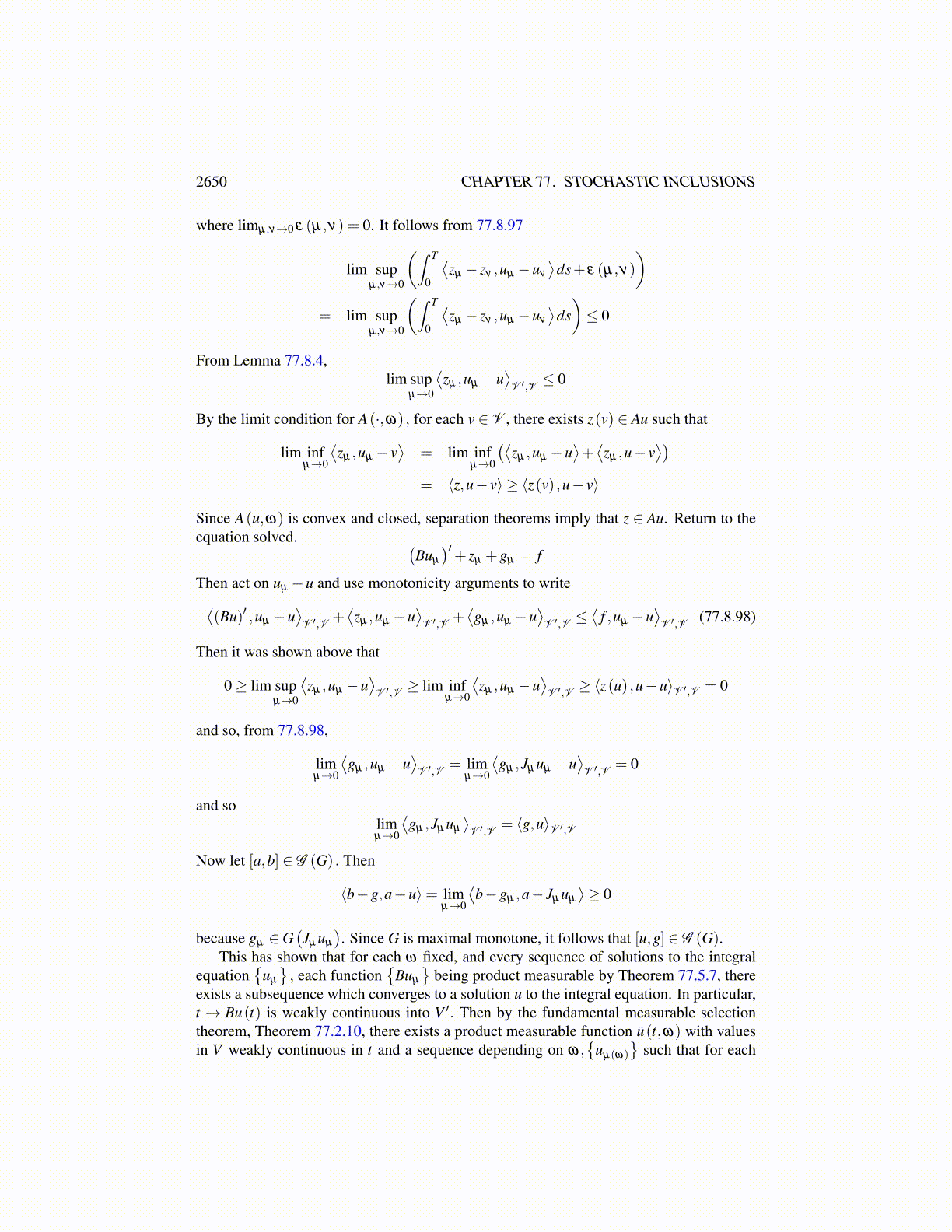
2650 CHAPTER 77. STOCHASTIC INCLUSIONS
Then returning to 77.8.82, all terms are bounded except∫ t
0⟨Gµ u,u
⟩ds, so this term must
also be bounded for t = T also. Thus∣∣∣∣∫ T
0
⟨Gµ u,u
⟩dt∣∣∣∣≤C
where C is independent of µ . We denote by uµ the solution to the above equation.Here is the definition of quasi-bounded.
Definition 77.8.8 A set valued operator G is quasi-bounded if whenever x ∈ D(G) andx∗ ∈ Gx are such that
|⟨x∗,x⟩| , ∥x∥ ≤M,
it follows that ∥x∗∥ ≤ KM . Bounded would mean that if ∥x∥ ≤M, then ∥x∗∥ ≤ KM . Hereyou only know this if there is another condition.
Assumption 77.8.9 G : D(G)→P (V ′) is quasi-bounded and maximal monotone.
By Proposition 25.7.23 an example of a quasi-bounded operator is a maximal monotoneoperator G for which 0 ∈ int(D(G)).
Now Gµ uµ ∈ GJµ uµ as noted above. Therefore, there exists gµ ∈ G(Jµ uµ
)such that
C≥⟨Gµ uµ ,uµ
⟩V ′,V =
⟨gµ ,uµ
⟩V ′,V =
⟨gµ ,Jµ uµ
⟩V ′,V +
⟨gµ ,uµ − Jµ uµ
⟩V ′,V (77.8.85)
≥ −|G(0)|∥∥Jµ uµ
∥∥V+
⟨− 1
µ p−1 F(Jµ uµ −uµ
),uµ − Jµ uµ
⟩V ′,V
= −|G(0)|∥∥Jµ uµ
∥∥V+
1µ p−1
∥∥Jµ uµ −uµ
∥∥pV
(77.8.86)
Thus the fact that∥∥uµ
∥∥ is bounded independent of µ implies that∥∥Jµ uµ
∥∥ is also boundedand that in fact
∥∥uµ − Jµ uµ
∥∥V→ 0 as µ → 0. This follows from consideration of the last
line of the above formula. Note also that⟨gµ ,uµ − Jµ uµ
⟩V ′,V =
1µ p−1
∥∥Jµ uµ −uµ
∥∥pV
is bounded. (77.8.87)
Then from 77.8.85, it follows that⟨gµ ,Jµ uµ
⟩V ′,V is bounded. By the assumption that G is
quasi-bounded, gµ must also be bounded.Then we have shown
Buµ (t,ω)+∫ t
0zµ (s,ω)ds+
∫ t
0gµ (s,ω)ds =
∫ t
0f (s,ω)ds+Bu0 (ω) (77.8.88)
where∥∥gµ
∥∥V ′ +
∥∥zµ
∥∥V ′ + sup
t∈[0,T ]
⟨Buµ ,uµ
⟩(t)+
∥∥Jµ uµ
∥∥V+∥∥uµ
∥∥V+∥∥∥(Buµ
)′∥∥∥V ′≤C
(77.8.89)